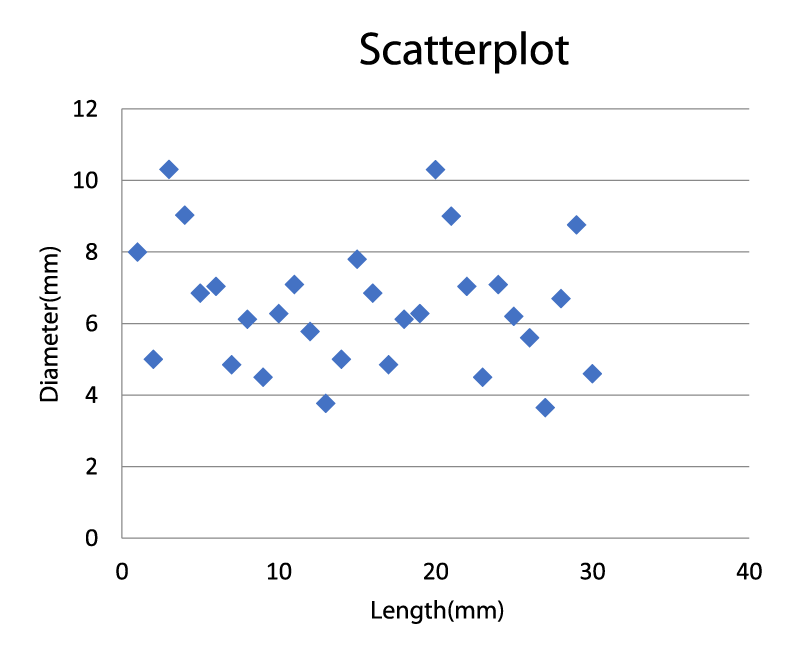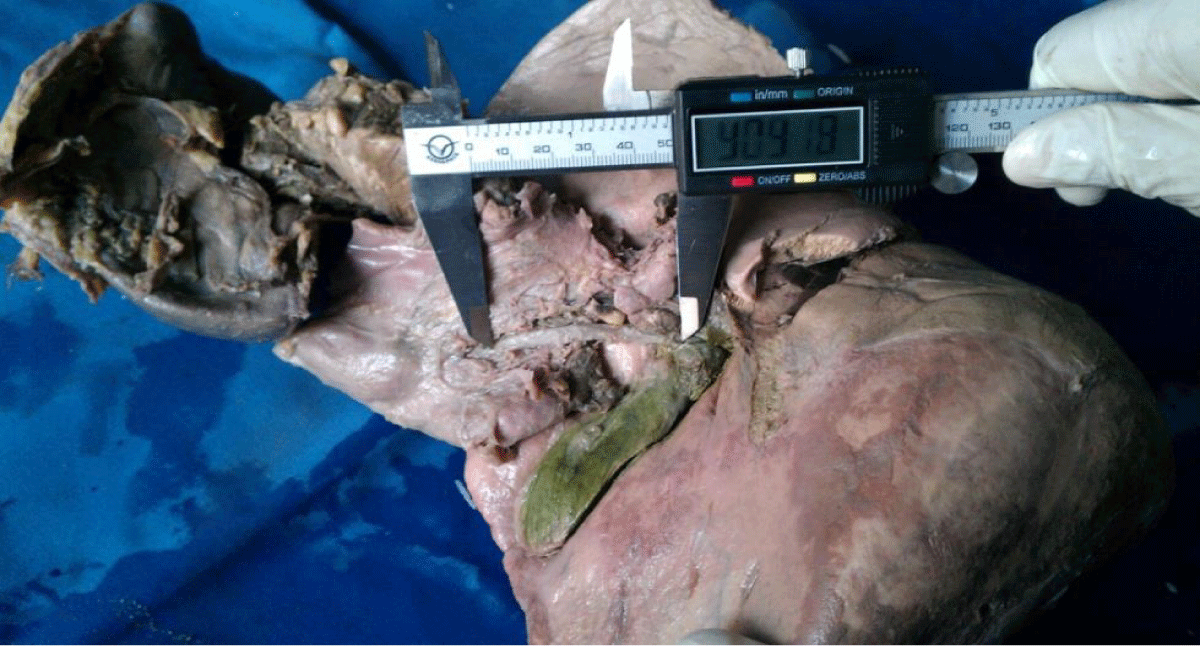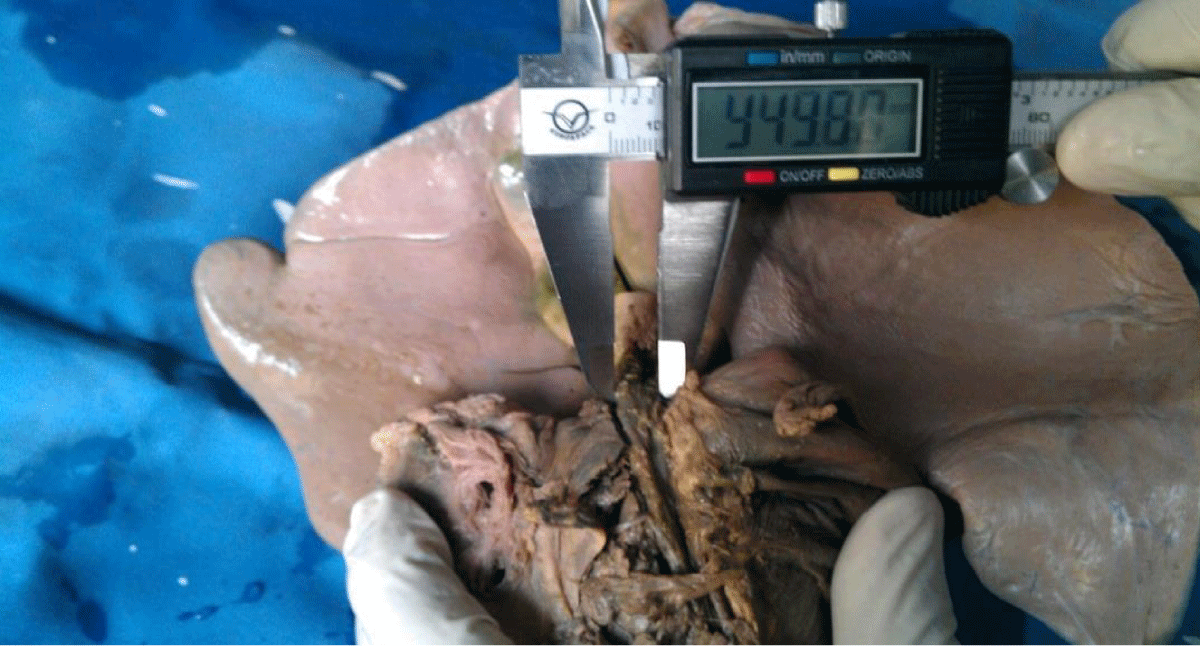> Medicine Group. 2021 Feb 23;2(2):064-068. doi: 10.37871/jbres1190.
Morphometric Analysis of Common Bile Duct: A Cadaveric Study
Sanjay Kumar Sah1*, Himal Panth2 and Ying Xiong Wang3
2Department of Basic Medicine, Universal College of Medical Sciences, Bhairahawa, Nepal
3Joint International Research Laboratory of Reproduction & Development, Chongqing Medical University, Chongqing, People’s Republic of China
- Biliary tree
- Common bile duct
- Measurement
- Biliary anatomic variations
Abstract
Introduction: Though human beings look similar in their general anatomical appearances but during the investigation of a particular structure in detail, it is surprising how frequently we meet one sort or another type of variation. Literature reports that accurate dimensions of CBD are debatable. Therefore, determination of a spontaneous abnormality or atypical variation is important and reference range plays a significant role to classify the normal or abnormal duct.
Materials and Methods: A total of thirty (30) cadavers were dissected at MGM Medical College Mumbai, India from Jan 2012 to March 2013 for anatomical features of the common bile duct-like their size, variations in the course and termination.
Results: The length of the common bile duct varies 35.19 mm to 62.43 mm with Mean ± SD 46.92 ± 7.91 mm and diameter varied between 3.65 mm to 10.31 mm with mean value 6.50 ± 1.77. The correlation between length and diameter of common bile duct is statistically insignificant (p = 0.243)
Conclusion: We established a reference range for the CBD length and diameter. Thus, the exact knowledge of the anatomy of the common bile duct is significant for successful hepato-biliary surgery and biliary pathology.
Introduction
The Common Bile Duct (CBD) is formed near the porta hepatis, by the union of cystic duct & common hepatic duct and responsible for the transportation of bile from liver & gall bladder to the duodenum. Normally, 6 to 8 cm in length, and its diameter tends to increase somewhat with the age but usually around 6 mm in adults [1].
The common bile duct descends within the lesser omentum immediately to the right of the hepatic artery proper and portal vein. Upon leaving the lesser omentum, passes behind the 1st part of the duodenum and the head of the pancreas before traversing the posteromedial wall of the 2nd part of duodenum along with the main pancreatic duct. The two ducts unite to form a dilated saccule called the hepatopancreatic ampulla (Ampulla of Vater), which opens into the lumen of the duodenum at the summit of the major duodenal papilla [2].
Background
The human body is thought to be singularly alike in their general anatomical construction but the anatomy of the biliary tree presents lots of variations. Dissection or radiological investigations reported anatomical variations of either the intra-hepatic or extra-hepatic bile ducts, which are found in approximately 50% of the general population. Understanding of the common patterns and normal measurements and their variations are important to the surgeons as it is essential for the reduction of morbidity and mortality rates during hepatobiliary surgery [3-5].
An abnormally dilated common bile duct has been considered as a clinical indication for choledochostomy [6]. Therefore, studies to determine the range of normality for the common bile duct length and breadth are essential as they would help in defining the patients suffering from obstructive jaundice [7]. However, studies done in the cadaver where the size of the Common Bile Duct (CBD) is measured are scarce. In the clinical setting, measurements of CBD are performed using either Sonography, magnetic resonance cholangiopancreatography, or computerized tomography scans [8] but in cadaver, the measurements are done by directly exposing the organ using a Vernier caliper. This study aimed at obtaining data by measuring the length and diameter of the CBD from cadavers to determine the normal reference range and find out the relationship between them.
Materials and Methods
Dissection
Dissection was performed according to the dissection manual detailed in [9]. Briefly, an incision was taken for reflecting the skin of the anterior abdominal wall. All the layers of the anterior wall were reflected and removed. The ribs and diaphragm were cut to allow the liver to be retracted superiorly, exposing the lesser omentum. The visceral surface of the liver was in contact with the gallbladder and the peritoneum covering the stomach, duodenum, and colon. The right kidney, and right suprarenal gland were identified.
The three large structures that are contained within the hepatoduodenal ligament; bile duct, hepatic artery, and portal vein were identified. The bile duct was lateral to the three structures followed by the common hepatic duct superiorly and portal vein medially. A probe was used to trace the bile duct superiorly and thus the cystic duct and common hepatic duct were identified. Now the bile duct was traced inferiorly by identifying its opening into the duodenum and carefully measured the length (Figure 1) and diameter (Figure 2) with the help of Vernier caliper.
Statistical Analysis
Data were entered and analyzed in SPSS Vs 20. All quantitative data are expressed as mean ± standard deviation. Correlation and Regression were used to find the relationship between dependent and independent variables. A P-Value of less than 0.05 was considered as statistically significant.
Results
Dimensions of the CBD
Length: A total of 30 cadavers were involved in the measurement of CBD length. The longest CBD had 62.43mm and the shortest had 35.19 mm. The mean length was 46.91 mm ± 7.90 mm (Table 1).
Table 1: Summary of the dimensions of the common bile duct measured from 30 embalmed adult human cadavers. |
||||
| Parameter (mm) | Sample size | Minimum | Maximum | Mean ± SD |
| Length | 30 | 35.19 | 62.43 | 46.92 ± 7.91 |
| Diameter | 30 | 3.65 | 10.31 | 6.50 ± 1.77 |
Diameter: The highest CBD diameter (n = 30) was recorded at 10.31mm and the lowest was 3.65 mm. The mean diameter was 6.50 mm ± 1.77 mm (Table 1).
Relationship between length and breadth: The average length of CBD is 46.92 ± 7.91 whereas its diameter is 6.50 ± 1.77. The Correlation results show a statistically insignificant low degree of negative correlation between the length and diameter of the common bile duct (p = 0.243). (Tables 2-4). This result indicates that per unit increase in length of common bile duct will be associated with a decrease of 0.49 units of its diameter.
Table 2: Correlation Table, shows the correlation between length and diameter of the common bile duct. |
|||
|
Length | Diameter | |
| Length | Pearson Correlation | 1 | -.220 |
| p-value | .243 | ||
| N | 30 | 30 | |
 Regression table |
|||
| Table 3: ANOVA Table. This table shows the output of the ANOVA analysis and whether there is a statistically non-significant difference between length and diameter of common bile duct. We can see that the significance value is 0.243 (i.e., p = 0.243), which is above 0.05. and, therefore, there is statistically non-significant. | ||||||
| Model | Sum of Squares | df | Mean Square | F | Sig. | |
| Regression | 4.400 | 1 | 4.400 | 1.420 | 0.243 | |
| Residual | 86.753 | 28 | 3.098 | |||
| Total | 91.153 | 29 | ||||
Table 4: Coefficient table provides us with the necessary information to predict length from breadth, as well as determine whether length contributes statistically significantly to the model (by looking at the "Sig." column). Furthermore, we can use the values in the "B" column under the "Unstandardized Coefficients" column, as shown below: |
||||||
| Model | Unstandardized Coefficients | Standardized Coefficients | t | Sig. | ||
| B | Std. Error | Beta | ||||
| (Constant) | 8.810 | 1.966 | 4.481 | < 0.001 | ||
| Length | -.049 | .041 | -.220 | -1.192 | .243 | |
Dependent Variable: Breadth of bile duct |
||||||
Discussion
This study was conducted among 30 cadavers belonging to the Mumbai city, India. The present study state the length of the common bile duct varied between 35.19 to 62.43 mm with a mean average length of 46.91 mm ± 7.90 mm and the diameter of the common bile duct varied between 3.65 mm to 10.31 mm with a mean average breadth of 6.50 mm ± 1.77 mm. According to Dana Blidaru, et al. [10] length of common bile was reported as 72.02mm ± 11.56 mm and breadth was 5.25 ± 1.28mm. Nidhi LAL et al reported the lower and upper limits of normal common bile duct diameter were found to be 2.0 mm and 7.9 mm respectively [7]. The diameter of CBD showed a considerable increase with age, where the largest diameter of the CBD was up to 6 mm in most of the patients up to the age of 50 yrs. and an upper limit of 8 mm appears reasonable after the age of 50 by Senturk, et al. [8].
According to previously published data in the literature regarding the dimensions of the common bile duct (length/ diameter) are: Rouvière H [11], 50 mm/5 mm, Testut L and Latarjet A [12], 60-80 mm/4-5 mm, Couinaud C [13], 80–100 mm/5–6 mm, Mahour GH, et al. [6], found diameters between 6.21 and 8.39 mm (a mean of 7.39 mm), and in the meantime, he observed an abatement of the diameter in older people, Leslie D, et al. [14], 5-17 mm (a mean of 12 mm) on normal ducts and 9–58 mm on pathological ducts, Hollinshead HW [15], 50-150 mm/6-8 mm, Anson BJ, et al. [16], 90 mm in length, Papilian V [17], 30-35 mm/ 5 mm, Bannister LH [18], 75 mm/6 mm. Among these results, the lowest length of CBD is 9 mm and the highest is 150 mm wherein the lowest diameter is 4 mm and the highest is 8.39 however the present study reported the length of lowest 35.19 mm & highest 62.43 mm while the diameter of lowest 3.65 mm and highest 10.31 are noted (Table 5).
| Table 5: Length and breadth of common bile duct reported by various authors. | ||||
| S. N. | Researcher Name | Year | Length (mm) | Diameter (mm) |
| 1 | Rouviere H | 1924 | 50.00 | 5.00 |
| 2 | Testula & Latarjet A | 1931 | 60-80 | 4.00- 5.00 |
| 3 | Couinand C | 1963 | 80.00-100.00 | 5.00-6.00 |
| 4 | Mahour GH et al | 1967 | - | 6.21-8.39 |
| 5 | Leslie D et al | 1968 | 9-58 | 5-17 |
| 6 | Holinshead HW | 1971 | 90 | - |
| 7 | Anson BJ et al | 1971 | 50-150 | 6.00-8.00 |
| 8 | Papilian V | 1979 | 30-35 | 5.00 |
| 9 | Banister LH | 1995 | 75 | 6.00 |
| 10 | Present study | 2013 | 35.19-62.43 | 3.65-10.31 |
The lower and upper limits of normal common bile duct diameter were found to be 3.77 mm to 10.31 mm respectively in our study. However, the majority of the study subjects (95%) had a common bile duct diameter of < 6 mm wherein 8 mm was recommended as the upper limit for common bile duct diameter reported by Behan, et al. [19] studies conducted by Testula & Latarjet Areported the lowest upper limit 5 mm. A study in Korea, Park, et al. [20] reported the average diameter of the common bile duct was 6.7 mm which is almost similar to our study. The lower limit of the breadth of the common bile duct is 3.65 mm in our study which is similar to that reported by Kaude JV, et al. [21].
A study conducted in Jordan, Daradkeh S, et al. [22], demonstrated a significant correlation with Body Mass Index (BMI). However, our study is limited where correlation with body mass index is excluded because of a cadaveric study. Mahour GH, et al. [6] found that the outer diameters of the duct varied in all subjects and the values ranged from 4 to 12 mm with an average of 7.39 mm whereas the presented study reported the average diameter of the bile duct is 6.50 mm.
Rodríguez-Luna MR, et al. [23] conducted a radiological study named transcystic intraoperative cholangiogram showed common bile duct duplication without signs of the biliary obstruction. Also, a case of double CBD was reported by Imamura H.et al and discussed the novel anatomical findings of the accessory CBD from the viewpoint of embryology [24]. However, the present study has not come across the duplication of the common bile duct. Aristotle S. et al reported an absence of common bile duct in one case out of 25 subjects where bile was drained by long cystic duct directly to the second part of duodenum whereas the present study has not found its absence [25].
A Study by Gwal K, et al. [26] provides normative measurements for the common bile duct for children up to age 10 years and the values range 1.1-4.0 mm and also suggested that the upper limits of the duct increase with the age. However, the present study has not included the children as a subject. The Correlation results of the present study show a statistically insignificant low degree of negative correlation between Length and Diameter of the bile duct (p = 0.243).
A study by Lal. N. reported that the correlation of common bile duct between diameter and various age groups is statistically and a linear trend was also observed with age. Besides, they did not find any statistically significant correlation of common bile duct diameter with sex [7]. Niederau, et al. [27] reported no correlation with height and body surface area; although the common bile duct showed correlation with weight and Jordan, Daradkeh, et al. [22] demonstrated a significant correlation with Body Mass Index (BMI). However the present study is limiting the correlation measurements between the length and diameter of the common bile duct.
Conclusion
The common bile duct has an average length of 46.92 ± 7.91 mm and an average diameter of 6.50 ± 1.77 mm. This study established the reference range of length and diameter of the common bile duct of human beings by a study performed in cadavers. Also, it found that there is a statistically insignificant correlation between length and diameter (p = 0.243).
Besides the variable range of dimensions, we have not found other anomalies like absence or duplication of CBD which has been reported in the pieces of literature. Knowledge of the variable range of dimensions of the common bile duct occupies an important place in the field of medicine and also significant for the surgeon to avoid iatrogenic ductal injuries and inadvertent complications during gallbladder, pancreas, and duodenum.
Recommendations
Common bile duct length was not observed to have a statistically significant correlation with diameter. It maybe due to sampling size was less so this study recommends that similar types of studies can be conducted with a large sample size.
References
- Borley NR. ABDOMEN AND PELVIS. In: Borley NR, editor. Gray’s Anatomy. 40th Edition ed. Churchill Livingstone: Elsevier. 2008.
- Frank JPDS, Susan. Gross Anatomy in the Practice of Medicine. First Edition. ed. Philadelphia,: Lea & Febiger; 1994 Feb;699.
- Chaib E, Kanas AF, Galvão FH, D’Albuquerque LA. Bile duct confluence: anatomic variations and its classification. Surg Radiol Anat. 2014 Mar;36(2):105-9. doi: 10.1007/s00276-013-1157-6. Epub 2013 Jul 2. PMID: 23817807.
- De Filippo M, Calabrese M, Quinto S, Rastelli A, Bertellini A, Martora R, Sverzellati N, Corradi D, Vitale M, Crialesi G, Sarli L, Roncoroni L, Garlaschi G, Zompatori M. Congenital anomalies and variations of the bile and pancreatic ducts: magnetic resonance cholangiopancreatography findings, epidemiology and clinical significance. Radiol Med. 2008 Sep;113(6):841-59. English, Italian. doi: 10.1007/s11547-008-0298-x. Epub 2008 Jun 30. PMID: 18592141.
- Kostov DV, Kobakov GL. Six rare biliary tract anatomic variations: implications for liver surgery. Eurasian J Med. 2011 Aug;43(2):67-72. doi: 10.5152/eajm.2011.16. PMID: 25610166; PMCID: PMC4261355.
- Mahour GH, Wakim KG, Ferris DO. The common bile duct in man: its diameter and circumference. Ann Surg. 1967 Mar;165(3):415-9. doi: 10.1097/00000658-196703000-00011. PMID: 6019316; PMCID: PMC1617512.
- Lal N, Mehra S, Lal V. Ultrasonographic measurement of normal common bile duct diameter and its correlation with age, sex and anthropometry. J Clin Diagn Res. 2014 Dec;8(12):AC01-4. doi: 10.7860/JCDR/2014/8738.5232. Epub 2014 Dec 5. PMID: 25653927; PMCID: PMC4316233.
- Senturk S, Miroglu TC, Bilici A, Gumus H, Tekin RC, Ekici F, Tekbas G. Diameters of the common bile duct in adults and postcholecystectomy patients: a study with 64-slice CT. Eur J Radiol. 2012 Jan;81(1):39-42. doi: 10.1016/j.ejrad.2010.11.007. Epub 2010 Dec 8. PMID: 21144686.
- Cunningham’s Manual of Practical Anatomy, Volume 2. Thorax and Abdomen (14th Edition). Postgraduate Medical Journal. 1979;55(644):436.
- Blidaru D, Blidaru M, Pop C, Crivii C, Seceleanu A. The common bile duct: size, course, relations. Rom J Morphol Embryol. 2010;51(1):141-4. PMID: 20191134.
- Rouviere. Anatomie humaine descriptive et topographique. Paris: Masson et Cie; 1970 1970.
- Testut L. Human anatomy. Paris Doin, 1899.
- C C. Anatomie de l’abdomen. Paris: Gaston Doin et Cie, Éditeurs, 1963.
- Leslie D. The width of the common bile duct. Surg Gynecol Obstet. 1968 Apr;126(4):761-4. PMID: 5643158.
- Hollinshead HW. Anatomy for surgeons. New York: Harper & Row Publishers, 1971.
- Anson B, Mcvay CB. Surgical anatomy. 5th edition ed. Philadelphia: WB Saunders Co, 1971.
- Papilian V. Anatomia omului: Didactică şi Pedagogică, Bucureşti, 1979.
- Williams PLBL. The anatomical basis of medicine and surgery. 38th edition ed. New York: Churchill Livingstone, 1995.
- Behan M, Kazam E. Sonography of the common bile duct: value of the right anterior oblique view. AJR Am J Roentgenol. 1978 Apr;130(4):701-9. doi: 10.2214/ajr.130.4.701. PMID: 205124.
- Park JS, Lee DH, Jeong S, Cho SG. Determination of Diameter and Angulation of the Normal Common Bile Duct using Multidetector Computed Tomography. Gut Liver. 2009 Dec;3(4):306-10. doi: 10.5009/gnl.2009.3.4.306. Epub 2009 Dec 31. PMID: 20431765; PMCID: PMC2852735.
- Kaude JV. The width of the common bile duct in relation to age and stone disease. An ultrasonographic study. Eur J Radiol. 1983 May;3(2):115-7. PMID: 6873071.
- Daradkeh S, Tarawneh E, Al-Hadidy A. Factors affecting common bile duct diameter. Hepatogastroenterology. 2005 Nov-Dec;52(66):1659-61. PMID: 16334751.
- Rodriguez-Luna MR, Guarneros-Zarate JE, Noriega-Usi VM, Terron-Arriaga RM, Rodriguez JF. Common Bile Duct Duplication Type Va. A Rare but Important Anatomical Variation to Know. Journal of gastrointestinal surgery: official journal of the Society for Surgery of the Alimentary Tract. 2017;21(12):2124-5.
- Imamura H, Eguchi S, Shapiro AMJ, Kin T. A case of double common bile duct in a deceased donor for transplantation. Surg Radiol Anat. 2017 Dec;39(12):1409-1411. doi: 10.1007/s00276-017-1874-3. Epub 2017 May 18. PMID: 28523346; PMCID: PMC5681599.
- Sharmila Aristotle CF, Sumathilatha Sakthivelavan. An Unusual Variation of Extra Hepatic Biliary Ductal System: Hepaticocystic Duct. Journal of Clinical and Diagnostic Research. 2011;5(5):984-5. doi: 10.18203/2320-6012.ijrms20172989
- Gwal K, Bedoya MA, Patel N, Rambhatla SJ, Darge K, Sreedharan RR, Anupindi SA. Reference values of MRI measurements of the common bile duct and pancreatic duct in children. Pediatr Radiol. 2015 Jul;45(8):1153-9. doi: 10.1007/s00247-015-3296-x. Epub 2015 Feb 20. PMID: 25698367.
- Niederau C, Müller J, Sonnenberg A, Scholten T, Erckenbrecht J, Fritsch WP, Brüster T, Strohmeyer G. Extrahepatic bile ducts in healthy subjects, in patients with cholelithiasis, and in postcholecystectomy patients: a prospective ultrasonic study. J Clin Ultrasound. 1983 Jan;11(1):23-7. doi: 10.1002/jcu.1870110106. PMID: 6403584.
Content Alerts
SignUp to our
Content alerts.
 This work is licensed under a Creative Commons Attribution 4.0 International License.
This work is licensed under a Creative Commons Attribution 4.0 International License.










